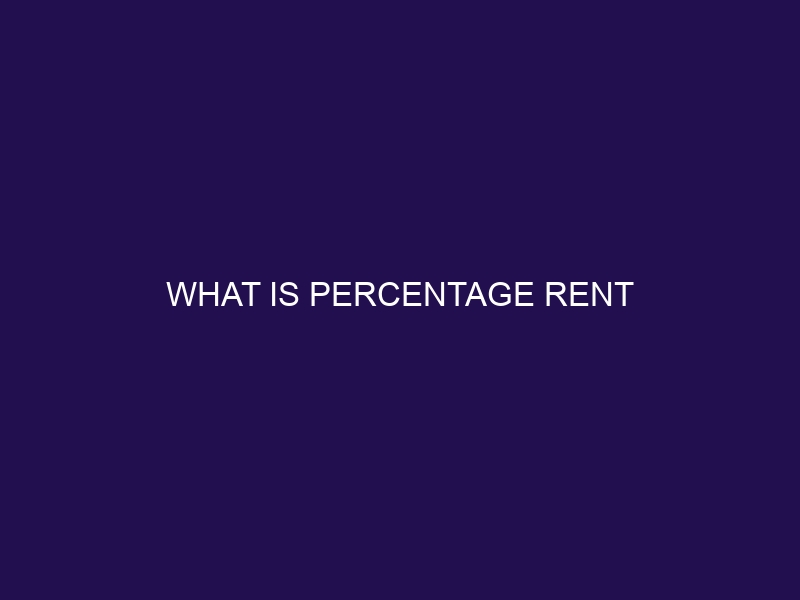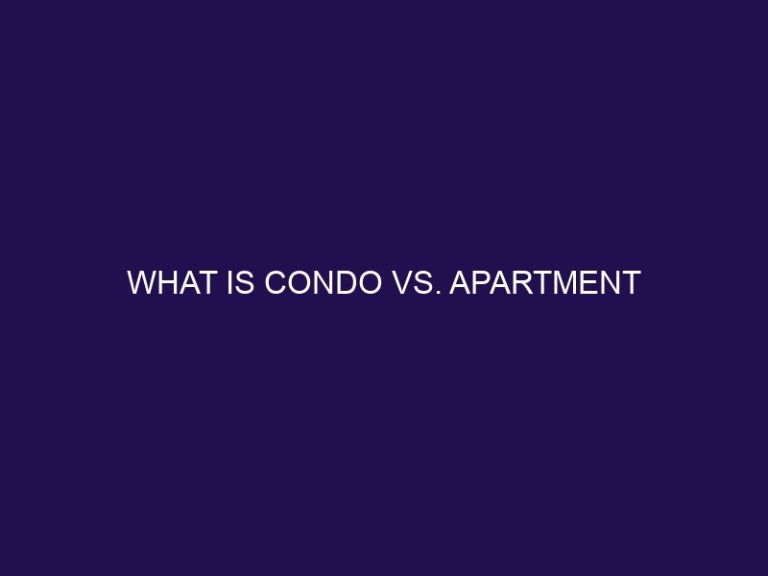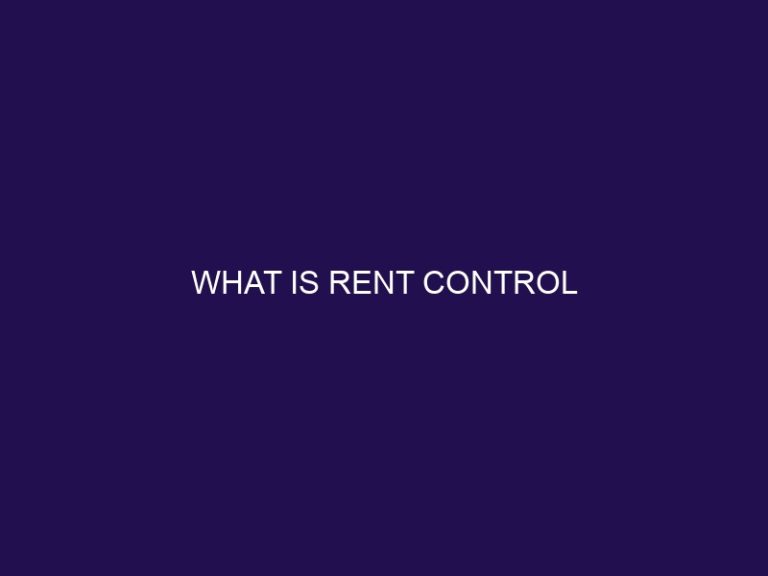What is Percentage Rent
Percentage rent is a leasing agreement commonly used in commercial real estate, where the tenant pays a base rent plus a percentage of their revenue as rent. This unique rent structure allows both landlords and tenants to benefit from the success of the business.
Percentage rent works by calculating the base rent, which is a fixed amount agreed upon in the lease, and then determining the percentage rent, which is a percentage of the tenant’s gross sales or revenue. The percentage rent is typically applied once the tenant surpasses a certain sales threshold.
Percentage rent is often used in retail and restaurant leases, where the landlord takes on some of the risk by tying rent to the tenant’s performance. This model incentivizes both parties to work together to maximize the tenant’s sales, as it directly affects the rent payment.
There are several benefits of percentage rent. It encourages a collaborative and mutually beneficial relationship between landlords and tenants, as their goals become aligned. It also ensures that rent is directly linked to the tenant’s performance, creating a fair and dynamic rental agreement.
For landlords, it is essential to set a reasonable base rent that covers expenses and provides a fair return on investment. Regular review and adjustment of the percentage rent can help maintain a balanced agreement.
Tenants should carefully consider their budget and cash flow to ensure they can meet both the base rent and percentage rent obligations. Negotiating the percentage rent terms should be done strategically to protect the business’s profitability.
Understanding Percentage Rent
Understanding percentage rent is crucial for both landlords and tenants to negotiate fair terms. Percentage rent is a type of lease agreement that allows landlords to earn a portion of a tenant’s sales revenue in addition to a fixed rent amount. This arrangement is commonly used in retail properties, where landlords take a percentage of sales to offset the risk of a fluctuating market. Factors such as the base rent, breakpoint, and percentage rate are important considerations in understanding percentage rent and its terms. Carefully reviewing and analyzing the terms of a percentage rent agreement before entering into a lease is essential.
What is Percentage Rent?
What is Percentage Rent?
Percentage rent, also known as sales based rent, is a type of rental agreement commonly used in commercial leasing. In this arrangement, the tenant pays a fixed base rent plus an additional percentage of their sales revenue to the landlord. This structure allows landlords to share in the success of their tenants and provides them with a stake in the business’s performance. The percentage rent is usually calculated as a percentage of the tenant’s gross sales, with a specified minimum base rent to ensure a consistent income for the landlord. This arrangement benefits both parties by aligning their interests and promoting the success of the tenant’s business.
| Definition | Percentage rent is a type of rental agreement used in commercial leasing. |
| Payment Structure | Tenants pay a fixed base rent plus an additional percentage of their sales revenue to the landlord. |
| Benefits | Landlords share in the success of their tenants and are motivated to support their businesses. |
| Calculation | The percentage rent is calculated as a percentage of the tenant’s gross sales, with a minimum base rent specified. |
How Does Percentage Rent Work?
In the world of commercial leasing, a key factor that can greatly impact a tenant’s rent is the concept of percentage rent. But how does percentage rent actually work? In this section, we’ll uncover the inner workings of this unique rental structure. From calculating the base rent to determining the elusive percentage rent, we’ll unravel the mechanics behind this fascinating aspect of commercial leasing. Get ready to delve into the world of numbers and percentages as we decode the intricacies of percentage rent.
Calculating the Base Rent
Calculating the Base Rent involves several steps. First, you need to determine the agreed upon base rent amount with the landlord. Next, you must calculate the tenant’s gross sales, which are the total sales revenue generated by the tenant over a specified period. After that, establish a breakpoint or threshold where the percentage rent kicks in. This predetermined sales amount is crucial. Once you have the breakpoint, subtract it from the gross sales to identify the excess sales. Then, apply the agreed upon percentage rate to the excess sales to calculate the additional rent owed. Finally, add the additional rent to the base rent to obtain the total rent owed for the period.
Determining the Percentage Rent
Determining the Percentage Rent involves the following steps:
- Calculate the base rent: Determine the fixed amount that the tenant pays regardless of their sales.
- Determine the percentage rent: Decide on the percentage of the tenant’s sales that will be added to the base rent.
- Set a threshold: Establish a point at which the percentage rent will be triggered, such as when the tenant’s sales exceed a certain amount.
- Calculate the percentage rent: Multiply the tenant’s sales that exceed the threshold by the agreed-upon percentage to determine the additional rent owed.
- Regularly review and adjust: Periodically evaluate and adjust the percentage rent based on changes in the tenant’s sales performance.
To effectively determine the Percentage Rent, landlords and tenants should communicate openly, consider market conditions, and seek legal advice if needed. This ensures a fair and mutually beneficial arrangement.
When is Percentage Rent Used?
When is Percentage Rent Used?
Percentage rent is commonly used in commercial real estate as a flexible payment structure between tenants and landlords. This type of rental agreement is particularly suitable for industries like retail or food service where sales fluctuate seasonally or due to market conditions. In addition to a base rent, the tenant’s payments are determined based on a percentage of their sales or gross revenue. This arrangement allows the landlord to share in the tenant’s success while also providing the tenant with more affordable rent during slower periods. So, percentage rent is typically employed when a tenant and landlord are seeking a payment system that caters to fluctuations in sales and provides mutual benefits.
Benefits of Percentage Rent
Discover the incredible perks of percentage rent! In this section, we’ll unveil how this unique approach benefits both landlords and tenants. From fostering stronger relationships to aligning rent with performance, the advantages are endless. So, buckle up and get ready to explore the exciting world of percentage rent and how it can revolutionize the way we think about leasing agreements. Let’s dive in and unlock the untapped potential of this innovative concept.
Incentivizes Landlord-Tenant Relationships
Incentivizing landlord-tenant relationships is a crucial aspect of percentage rent agreements. This can be achieved through various means and benefits both parties involved. Here are some ways in which percentage rent incentivizes landlord-tenant relationships:
- Shared success: With percentage rent, landlords have a vested interest in the success of their tenants. As the tenant’s sales increase, so does the landlord’s rent income.
- Collaboration: Landlords and tenants are more likely to collaborate and work together to attract customers and improve the overall performance of the property.
- Mutual understanding: By linking rent to sales, both parties gain a better understanding of the challenges and opportunities within the business, leading to more open communication and cooperation.
- Flexibility: Percentage rent agreements often provide flexibility for both landlords and tenants. They can adapt to changing market conditions and ensure a fair and equitable rental structure.
True history: One example of how percentage rent incentivized landlord-tenant relationships is the collaboration between John Rockefeller and the tenants of Rockefeller Center during the Great Depression. Rockefeller implemented percentage rent agreements, allowing struggling businesses to pay a lower base rent but share a portion of their sales when the economy improved. This arrangement helped sustain the tenants during challenging times and fostered long-term partnerships between landlords and tenants.
Aligns Rent with Performance
Aligning rent with performance offers numerous advantages for both landlords and tenants. This approach incentivizes landlord-tenant relationships by fostering open communication and collaboration. When rent is linked to the tenant’s business performance, both parties have a vested interest in the success of the business. Additionally, it encourages business growth as tenants are driven to increase sales and improve their business performance, which directly affects the amount of rent they need to pay. This can lead to enhanced revenue and overall business growth. Moreover, aligning rent with performance ensures fairness and transparency since tenants only pay higher rent when their business is thriving. This approach provides a just and transparent method of determining rent based on actual business performance. To illustrate this, consider the example of a small boutique clothing store that rented space in a busy shopping center. They entered into a percentage rent agreement with the landlord, where they paid a base rent as well as a percentage of their monthly sales. As the store diligently worked to attract customers and increase sales, their rent payments gradually increased. This system aligned the rent with the success of the business, allowing the landlord to receive a fair share of the store’s profits while supporting the store’s growth. Consequently, both the landlord and tenant formed a robust partnership founded on shared success.
Considerations for Landlords
When it comes to being a landlord, there are crucial considerations to keep in mind. In this section, we will explore the factors that landlords need to take into account to ensure a fair and profitable rental agreement. From setting a reasonable base rent that attracts tenants to the periodic review and adjustment of rental rates, we’ll delve into the strategies landlords can employ for long-term success. So, let’s dive in and discover the key considerations that shape the landlord’s journey.
Setting a Reasonable Base Rent
Setting a Reasonable Base Rent
Setting a reasonable base rent is crucial for both landlords and tenants in a percentage rent arrangement. Here are some steps to consider:
- Research the local market to understand the average base rent for similar properties.
- Consider the location and desirability of the property when determining the base rent.
- Evaluate the property’s condition, amenities, and any additional costs for maintenance or improvements.
- Factor in the potential revenue generated by the tenant and their business.
- Negotiate with the tenant to find a mutually beneficial base rent that accounts for both parties’ needs.
Pro Tip: It’s essential to regularly review and adjust the base rent to ensure fairness and keep up with market conditions.
Periodic Review and Adjustment
Periodic review and adjustment is an important aspect of percentage rent agreements between landlords and tenants. It helps ensure that the terms and conditions of the lease remain fair and equitable over time. Here are the steps involved in the process:
- Establish a review schedule, specifying how often the rent will undergo periodic review and adjustment to maintain fairness.
- Gather relevant financial data from both the landlord and the tenant, such as sales figures and market conditions, to support the periodic review and adjustment process.
- Analyze the data to determine if there is a need for adjustment based on changes in sales performance or market trends during the periodic review.
- Negotiate any proposed changes to the rent with the tenant during the periodic review and adjustment phase, taking into consideration their financial viability and the overall lease agreement.
- Document the updated rent terms in a formal agreement, ensuring both parties understand and agree to the new terms resulting from the periodic review and adjustment.
- Implement the adjusted rent, allowing for any necessary changes to rental payment structures or other lease-related terms following the periodic review and adjustment.
- Monitor the effectiveness of the adjusted rent over time and address any issues or concerns that may arise through ongoing periodic review and adjustment.
Considerations for Tenants
When it comes to considering the unique aspects of percentage rent as a tenant, there are a few key considerations to keep in mind. From budgeting and managing cash flow to negotiating favorable terms, we’ll explore the ins and outs of these important aspects. So, let’s dive in and discover how tenants can navigate the realm of percentage rent with confidence and success.
Budgeting and Cash Flow
Budgeting and cash flow are crucial considerations when it comes to managing percentage rent for both landlords and tenants. Here are a few steps to take into account:
-
Thoroughly analyze your financial situation to determine how much you can allocate towards rent.
-
Create a detailed budget that takes into account all your expenses, including budgeting and cash flow for percentage rent.
-
Monitor your cash flow regularly to ensure that you have enough funds to cover both fixed rent and any percentage rent obligations.
-
Consider negotiating the percentage rent terms in your lease agreement to ensure that it aligns with your budgeting and cash flow capabilities.
-
Explore strategies to increase revenue to mitigate the impact of variable percentage rent payments.
Remember, effective budgeting and monitoring of cash flow will help you manage percentage rent obligations more efficiently and avoid any financial strain.
Negotiating the Percentage Rent
Negotiating the percentage rent is a crucial process for landlords and tenants alike. Achieving a mutually beneficial agreement involves considering the following factors:
- Evaluate the market: Thoroughly research comparable properties and their rental terms to establish a fair starting point for negotiations.
- Identify performance indicators: Engage in discussions about the specific factors that will determine the percentage rent, such as gross sales or net profit.
- Flexibility: It is essential to include provisions that allow for adjustments in unforeseen circumstances, such as economic downturns.
- Communication: Maintain open and transparent communication throughout the negotiation process to foster a positive working relationship.
- Seek professional advice: For the right guidance, it is recommended to involve a specialized real estate attorney or broker who focuses on commercial leases.
During the negotiation process for the percentage rent of a retail space, the landlord acknowledged the tenant’s request for an initial rent reduction. In exchange, the tenant proposed a higher percentage rent, demonstrating their confidence in future performance. Through open dialogue and collaboration, both parties came to an agreement that aligned their interests and ultimately benefited their respective businesses.
Frequently Asked Questions
What is percentage rent?
Percentage rent, also known as a percentage lease, is a type of lease commonly used in commercial real estate. It is a rental charge based on the gross income of the tenant, rather than a fixed monthly or annual value.
How does percentage rent work?
The percentage rent usually applies after a certain amount of base rent has been paid, known as the breakpoint. If a tenant’s income exceeds the breakpoint, they are required to pay a percentage of their income as rent in addition to the base rent.
What are the advantages of percentage rent?
Percentage rent allows for lower rent during months of low revenues and higher rent during profitable seasons. It reflects changes in sales, which can be beneficial for businesses with variable income.
How is the breakpoint calculated?
The breakpoint can be calculated in two ways. A natural breakpoint is determined by dividing the minimum annual base rent by the percentage rent. An artificial breakpoint is a specified amount of gross sales, and the percentage rent applies to any amount over this specified amount.
Can a lease have only percentage rent and no base rent?
While it is uncommon, some leases may be purely percent-based with no base rent component. However, most leases still require paying base rent in addition to percentage rent.
What types of businesses commonly use percentage rent?
Percentage rent is often used in retail settings where income is highly variable, such as strip malls and shopping centers. Retail tenants, especially those in prime locations, may benefit from the flexibility of percentage rent.







